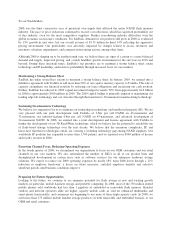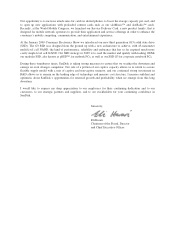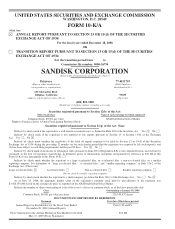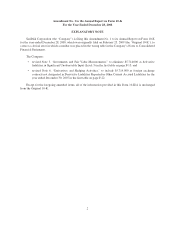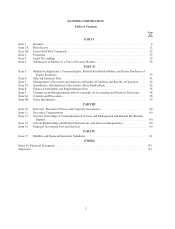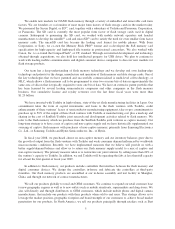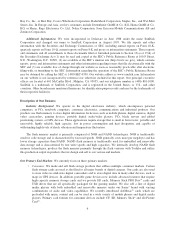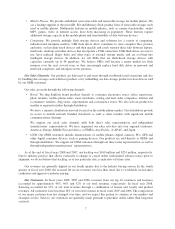SanDisk 2008 Annual Report Download - page 3
Download and view the complete annual report
Please find page 3 of the 2008 SanDisk annual report below. You can navigate through the pages in the report by either clicking on the pages listed below, or by using the keyword search tool below to find specific information within the annual report.To our Stockholders,
2008 was the third consecutive year of persistent over-supply that afflicted the entire NAND flash memory
industry. The pace of price reductions continued to exceed cost reductions, which has squeezed profitability out
of this industry, even for the most competitive suppliers. Further exacerbating industry difficulties were the
global economic recessionary conditions. For SanDisk, demand for our products still grew in 2008 as evidenced
by 15% growth in unit sales, but our overall revenue of $3.35 billion declined 14% reflecting the aggressive
pricing environment. Our profitability was adversely impacted by charges related to excess inventory and
inventory valuation, impairments, and company restructuring actions, among other items.
Although 2009 is shaping up to be another tough year, we believe there are signs of a return to a more balanced
demand and supply, improved pricing, and a much healthier growth environment for the survivors in 2010 and
beyond. During these uncertain times, SanDisk’s top priorities are to maintain a strong balance sheet, retain
technology and IP leadership, and return to profitability through increased focus on core markets.
Maintaining a Strong Balance Sheet
SanDisk has taken several key actions to maintain a strong balance sheet. In January 2009, we entered into a
definitive agreement with Toshiba to sell more than 20% of our captive memory capacity to Toshiba. This sale of
capacity strengthens our financial position by reducing our lease obligations and increasing our cash position.
Further, SanDisk has reduced its 2009 capital investment budget by nearly 70% from approximately $1.6 billion
in 2008 to approximately $500 million in 2009. The 2009 capital budget is primarily targeted at maintaining our
leading edge fab technology and cost structure through the transition to 32-nanometer manufacturing technology.
Sustaining Investments in Technology
We believe it is imperative for us to maintain our leadership in technology and intellectual property (IP). We are
very pleased with our joint development with Toshiba of 3-bits per cell NAND on 43-nanometer and
32-nanometer, our industry-leading 4-bits per cell NAND on 43-nanometer, and advanced development of
24-nanometer NAND. In 2008, we entered into a joint development and license agreement with Toshiba to
further the development of our 3D Read/Write technology, which we believe has the potential to extend the use
of flash-based storage technology over the next decade. We believe that the enormous complexity, IP, and
know-how that these technologies entail, are creating a widening technology gap among NAND suppliers. Our
worldwide IP portfolio has expanded to more than 1,700 patents, and we reported over $500 million of license
and royalty revenue in 2008.
Renewing Channel Focus, Reducing Operating Expenses
In the fourth quarter of 2008, we streamlined our organization to focus on our OEM customers and our retail
channels in our core markets. We also rationalized the number of SKUs in all of our product lines and
deemphasized development in certain areas such as software services for our enterprise hardware storage
solutions. We expect to reduce our 2009 operating expenses by nearly 18% from 2008 levels through a 12%
reduction in employee headcount, a freeze on salary increases, curtailed employee benefits and selective
shutdown periods until business conditions improve.
Preparing for Future Opportunities
Looking to the future, we continue to see immense potential for flash storage in new and existing growth
markets, in particular, mobile handsets storage and portable computing. In 2008, most of the 750 million slotted
mobile phones sold worldwide had less than 1 gigabyte of embedded or removable flash memory. Handset
vendors and network operators alike see higher capacity mobile cards as vital for enhanced multimedia and
smart-phone functionality, and consumers are beginning to use more of these high-capacity cards. In 2008, we
sold more than 175 million mobile handset storage products, in both removable and embedded formats, to our
OEM and retail customers.



